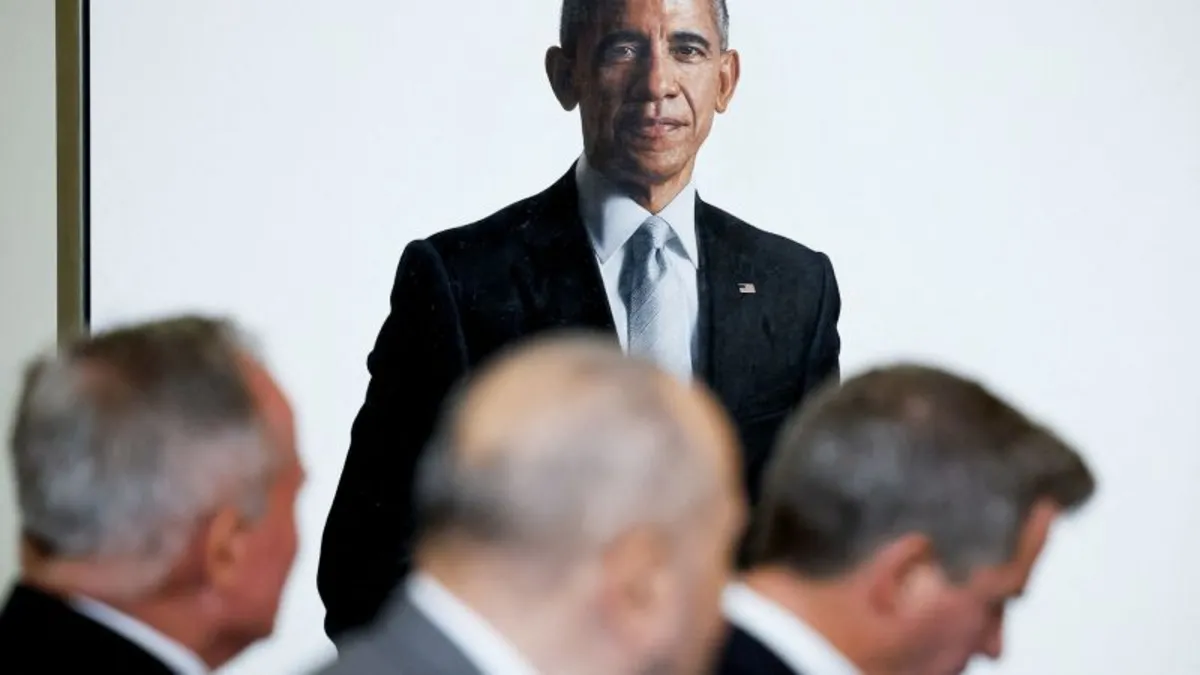
Once a striking feature of the White House entryway, the official portrait of former President Barack Obama has been relocated to a less prominent position, highlighting the ongoing tensions between the 44th and 47th presidents. This change is part of a broader trend, as portraits of other recent predecessors who had contentious relationships with President Donald Trump, such as former Presidents George W. Bush and George H. W. Bush, have also been moved.
According to two sources familiar with the situation, Trump directed his staff to relocate the Obama portrait to the top of the Grand Staircase, effectively placing it out of sight for the thousands of visitors who tour the White House daily. This move positions the portrait in a corner at the landing of the entrance to the private residence, an area that is heavily restricted to members of the first family, U.S. Secret Service agents, and a limited number of White House staff. As a result, the photorealistic painting of Obama, created by artist Robert McCurdy, is no longer visible to the general public.
This is not the first instance of the Obama portrait being repositioned. Earlier in April, it was moved across the Grand Foyer of the White House and replaced with a painting depicting a dramatic scene of Trump surviving an assassination attempt in Butler, Pennsylvania. Traditionally, White House protocol dictates that portraits of the most recent American presidents should be prominently displayed in the entrance of the executive mansion, allowing guests to view them during official events and tours. Notably, a portrait of current President Joe Biden has yet to be completed.
The repositioning of the Obama portrait marks another chapter in Trump’s ongoing rivalry with Obama. Tensions have escalated in recent months, with Trump accusing Obama and members of his administration of treason during the 2016 election. In response, Obama’s office described Trump’s claims as “outrageous,” “bizarre,” and a “weak attempt at distraction.” Following this, Trump's attorney general, Pamela Bondi, initiated a grand jury investigation into allegations that top officials from the Obama administration fabricated intelligence regarding Russia’s interference in the 2016 election.
Additionally, longstanding tensions exist between Trump and the Bush family. The late George H. W. Bush labeled Trump a “blowhard” in a biography and voted for Hillary Clinton in the 2016 election. Meanwhile, George W. Bush, whom Trump has criticized as a “failed and uninspiring” president, attended Trump's inauguration in 2025 but skipped the post-ceremony luncheon. CNN has reached out to both the White House and the White House Historical Association for comments, while a spokesperson for Obama’s office opted not to respond.
During Trump's first term, he made notable changes to the portraits displayed in the Grand Foyer, replacing those of Bill Clinton and George W. Bush with those of William McKinley and Theodore Roosevelt. The tradition of presidential portraits, which is privately funded by the nonprofit White House Historical Association, began in the early 1960s under First Lady Jacqueline Kennedy. Former White House curator Betty Monkman noted that prior to this period, portrait placements were rather haphazard, with funding coming from various sources, including Congress and friends of the presidents.
In modern times, unveiling ceremonies for presidential portraits typically include invitations extended to predecessors, former staff, and family, reflecting a spirit of generosity from the sitting president and first lady. Monkman recalls a ceremony during the Johnson administration for the unveiling of Eleanor Roosevelt’s portrait, which exemplifies this tradition.
Correction: A previous version of this story inaccurately described Pamela Bondi's role within the Trump administration. She served as the attorney general.